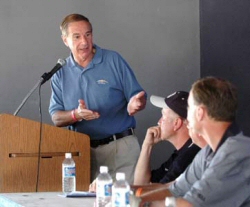User fee reality - Boyer tells Oshkosh crowd 'be very concerned'
 AOPA President Boyer explains the dangers of user fees to an Oshkosh audience. |
| |
$30 for a flight service station "consultation," plus an additional $5.31 for each forecast product used. That's GA reality in the United Kingdom.
$1.50 per minute for an FSS briefing in Germany. $1,000 for a private pilot knowledge test in the Netherlands.
In Austria, $31 to fly an ILS approach, and $70 to land after the approach. "In my situation, it's actually cheaper to fly the whole family by airline to the United States, rent an aircraft for about 30 hours, and have a nice two-week vacation (including hotel and rental car costs) than flying the same amount of hours in Europe," wrote an Austrian pilot to AOPA President Boyer.
In New Zealand, the wife of a pilot tells of how her husband complained about the expense of getting a briefing and filing a flight plan. He was killed in a weather-related accident. He'd skipped the briefing and hadn't filed.
"That's the reality of user fees and their impact on general aviation around the world," Boyer told an Oshkosh audience Tuesday. "That's what it could mean to all of you if we allow the user fee camel to stick its nose under the tent here in the United States."
AOPA joined forces with leaders from EAA, the National Business Aviation Association, General Aircraft Manufacturers Association, Cessna Aircraft Company, and Cirrus Design Corporation to present a forum on the very real threat of user fees for general aviation.
Airline threat
The threat comes from the airline industry, specifically the Air Transport Association, the airlines' association. With the FAA's funding authorization up for renewal next year in Congress, the airlines are trying to take advantage of the situation to change the entire funding system, shift some of their costs to other users, and move Congress out of the picture.
The airlines are trying to divide and conquer the GA community by proposing to exempt the majority of general aviation aircraft, piston-engine airplanes, from their user-fee plan. (See " Airlines concede victory to AOPA on user fees.")
Special GA treatment is only temporary
But the Canadian reality proves that you can't compromise for special treatment.
With both the current and former presidents of AOPA's sister organization - the Canadian Aircraft Owners and Pilots Association - sitting in the audience, Boyer explained that when Canada privatized its air traffic control system (called Nav Canada), it created a "recreational aircraft" category that would be exempt from the user fees charged to others. For a seat on Nav Canada's board and an understanding that GA would continue to pay through the aviation fuel tax, GA accepted the deal.
But the Canadian government didn't. It refused to drop the fuel tax, and Nav Canada had to find another way for GA to pay. So now GA pays an annual fee, plus a fuel tax almost twice as high as the U.S. tax. But the tax money goes to the government, not Nav Canada, and the government spends it on things other than aviation.
But Nav Canada's board of directors (where the airlines have four times as many representatives as GA) recently determined that some users weren't paying their "fair share" and voted for "revenue neutral" rate adjustments - GA pays more, the airlines pay less. (See " GA defeat in Canada.")
Keep Congress in the left seat
"We must keep Congress as our board of directors for the FAA," said Boyer. "And Congress is who will have the final say in the user fee debate."
"The elections present a good opportunity for pilots to bring attention to the user fee debate at town meetings with their local representatives," Boyer exhorted the Oshkosh crowd. "Stay involved in this issue."
Boyer shared a letter from AOPA member Gary D. Lux with the audience. "Dear Phil, I recently returned from vacation in Italy. While there, I visited a GA / Commercial airport outside of Perugia, Italy. That's when the issue of user fees came into focus for me. It hit me like the kick from a mule between the eyes.
"I was shocked at what I didn't see. I didn't see an active FBO or a flight line full of GA aircraft waiting to take flight. Instead, I saw a padlocked FBO, one older model Cessna and a couple of much older singles that I didn't recognize. Except for the Cessna, they were all in pretty bad shape and it was obvious they hadn't been flown in years.
"I asked the only GA pilot/mechanic I could find what had happened to the Aero Club and where could I buy a sectional chart for the area. He said there was no place to buy the sectional, and the aero club had been abandoned because the pilots could no longer afford to fly.
"In broken English he explained, 'They charge too much to fly above 3000 feet. So most of the pilots have gone to ultra-lights and fly below 3000 feet now.'"
The user fee panel at AirVenture included Boyer; NBAA President Ed Bolen; GAMA President Pete Bunce; Cessna Chairman, CEO, and President Jack Pelton; Cirrus President and CEO Alan Klapmeier; and EAA President Tom Poberezny.
July 26, 2006


